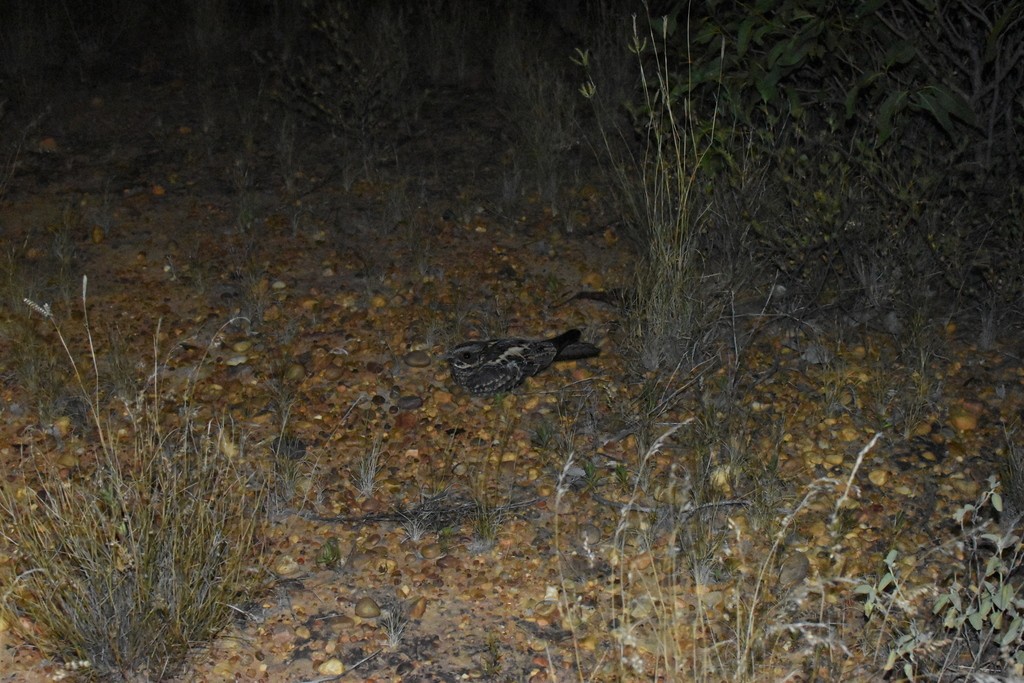Spotted Nightjar
A species of Australasian Eared Nightjars Scientific name : Eurostopodus argus Genus : Australasian Eared Nightjars
Spotted Nightjar, A species of Australasian Eared Nightjars
Botanical name: Eurostopodus argus
Genus: Australasian Eared Nightjars
Content
Description General Info
 Photo By sbarton16 , used under CC-BY-NC-4.0 /Cropped and compressed from original
Photo By sbarton16 , used under CC-BY-NC-4.0 /Cropped and compressed from original Description
One of the larger and more colourful of the nightjars, the intricate, heavily spotted and flecked patterns of the spotted nightjar enable it to blend perfectly where red, grew or brown soils are strewn with rocks, leaves, branches and twigs. Similar in appearance to two other Australian nightjar species, the large-tailed nightjar (Caprimulgus macrurus) and white-throated nightjar (Eurostopodus mystacalis), an adult spotted nightjar in flight displays large white spots on four outer primary feathers, lacking the white tail markings of the more tropical large-tailed nightjar. Adult body length is 25–28 cm. Adult males weigh 81-132 g while adult females are slightly smaller (74–123 g). Adult wingspan is 20.5-23.9 cm; tail length is 13.4-16.8 cm and bill length is 1.5-2.5 cm. The spotted nightjar's bill is flesh-brown to blackish, occasionally paler nearer to the gape of the lower mandible. The iris is brown to very dark brown; legs and feet are brown with darker claws. 
Size
35 cm
Nest Placement
Ground
Feeding Habits
Spotted Nightjar predominantly consume insects such as moths, beetles, and grasshoppers, catching their prey in flight, typically near the ground. They employ nocturnal aerial foraging and may ingest water by skimming over surfaces, with a notable preference for obtaining fluids from their prey.
Habitat
Spotted Nightjar occupies semi-arid to arid terrains, primarily across tropical and subtropical zones. Preferring open to lightly wooded landscapes, their habitats include savannas, open woodlands with dominating acacia, mallee, spinifex, and tussock grasslands, and scrublands. While they adapt to stony and sandy grounds littered with leaves, spotted Nightjar avoids dense grasslands and closed forests.
Dite type
Insectivorous
General Info
Feeding Habits
Bird food type
Behavior
A crepuscular/nocturnal species most active after dark and before dawn, spotted nightjars are usually observed roosting, walking or running along the ground and are rarely seen perching in trees. They are often found on roads at night and have been observed hawking insects with highly maneuverable flight around campfires, artificial lighting and flowering bushes. When flushed, individuals may initially fly only a short distance before landing, but when facing more persistent threats may fly further away beyond sight. If threatened while brooding, the spotted nightjar may begin hissing, opening its bill widely and spreading its wings and tail in a defensive posture or distraction display. The species typically roosts in partly shaded sites, often camouflaged amongst leaf litter or on stony ground. They manage to endure high temperatures during the hottest periods by gular-fluttering (evaporative cooling) and by keeping their backs to the sun, while also maintaining relatively low metabolic rates. While the species generally occurs singularly, flocks of up to 15 birds have been observed during migration. 
Distribution Area
The spotted nightjar occurs across most of mainland Australia, although it is generally absent east and south of the Great Dividing Range along the eastern seaboard from central Queensland to southeast South Australia and does not occur in Tasmania. Individuals may be locally nomadic or sedentary in northern regions, while southern birds are partially sedentary or migratory, wintering in northern Australia from May to September. The species may also winter on Indonesian islands in the Banda Sea, possibly for some individuals as a result of overshooting, with vagrants recorded as far north as Irian Jaya. 
Species Status
Previously considered moderately abundant across inland and northern areas, the spotted nightjar may be becoming more rare, particularly in southern parts of its range as a result of habitat loss associated with land clearing, reduced productivity and overgrazing of remnant native vegetation. Predation by feral cats and foxes is also likely to be significantly impacting abundance in some areas. The species is now listed among Australia's 26 declining woodland birds. 
Scientific Classification
Phylum
Chordates Class
Birds Order
Nightjars and Relatives Family
Nightjars and nighthawks Species
Spotted Nightjar